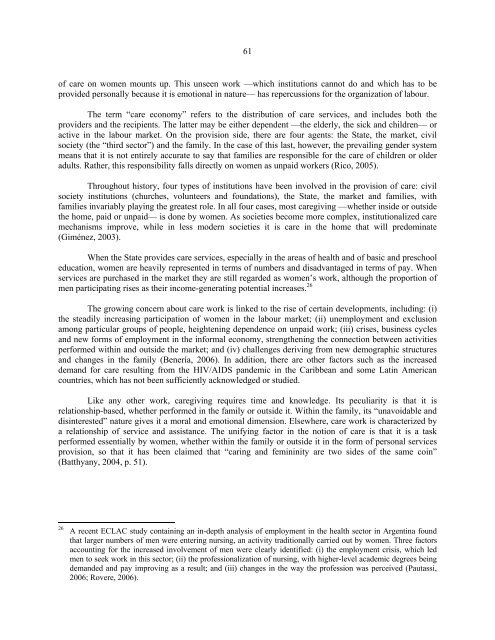Women in Latin America and the Caribbean - Cepal
Women in Latin America and the Caribbean - Cepal
Women in Latin America and the Caribbean - Cepal
Create successful ePaper yourself
Turn your PDF publications into a flip-book with our unique Google optimized e-Paper software.
61<br />
of care on women mounts up. This unseen work —which <strong>in</strong>stitutions cannot do <strong>and</strong> which has to be<br />
provided personally because it is emotional <strong>in</strong> nature— has repercussions for <strong>the</strong> organization of labour.<br />
The term “care economy” refers to <strong>the</strong> distribution of care services, <strong>and</strong> <strong>in</strong>cludes both <strong>the</strong><br />
providers <strong>and</strong> <strong>the</strong> recipients. The latter may be ei<strong>the</strong>r dependent —<strong>the</strong> elderly, <strong>the</strong> sick <strong>and</strong> children— or<br />
active <strong>in</strong> <strong>the</strong> labour market. On <strong>the</strong> provision side, <strong>the</strong>re are four agents: <strong>the</strong> State, <strong>the</strong> market, civil<br />
society (<strong>the</strong> “third sector”) <strong>and</strong> <strong>the</strong> family. In <strong>the</strong> case of this last, however, <strong>the</strong> prevail<strong>in</strong>g gender system<br />
means that it is not entirely accurate to say that families are responsible for <strong>the</strong> care of children or older<br />
adults. Ra<strong>the</strong>r, this responsibility falls directly on women as unpaid workers (Rico, 2005).<br />
Throughout history, four types of <strong>in</strong>stitutions have been <strong>in</strong>volved <strong>in</strong> <strong>the</strong> provision of care: civil<br />
society <strong>in</strong>stitutions (churches, volunteers <strong>and</strong> foundations), <strong>the</strong> State, <strong>the</strong> market <strong>and</strong> families, with<br />
families <strong>in</strong>variably play<strong>in</strong>g <strong>the</strong> greatest role. In all four cases, most caregiv<strong>in</strong>g —whe<strong>the</strong>r <strong>in</strong>side or outside<br />
<strong>the</strong> home, paid or unpaid— is done by women. As societies become more complex, <strong>in</strong>stitutionalized care<br />
mechanisms improve, while <strong>in</strong> less modern societies it is care <strong>in</strong> <strong>the</strong> home that will predom<strong>in</strong>ate<br />
(Giménez, 2003).<br />
When <strong>the</strong> State provides care services, especially <strong>in</strong> <strong>the</strong> areas of health <strong>and</strong> of basic <strong>and</strong> preschool<br />
education, women are heavily represented <strong>in</strong> terms of numbers <strong>and</strong> disadvantaged <strong>in</strong> terms of pay. When<br />
services are purchased <strong>in</strong> <strong>the</strong> market <strong>the</strong>y are still regarded as women’s work, although <strong>the</strong> proportion of<br />
men participat<strong>in</strong>g rises as <strong>the</strong>ir <strong>in</strong>come-generat<strong>in</strong>g potential <strong>in</strong>creases. 26<br />
The grow<strong>in</strong>g concern about care work is l<strong>in</strong>ked to <strong>the</strong> rise of certa<strong>in</strong> developments, <strong>in</strong>clud<strong>in</strong>g: (i)<br />
<strong>the</strong> steadily <strong>in</strong>creas<strong>in</strong>g participation of women <strong>in</strong> <strong>the</strong> labour market; (ii) unemployment <strong>and</strong> exclusion<br />
among particular groups of people, heighten<strong>in</strong>g dependence on unpaid work; (iii) crises, bus<strong>in</strong>ess cycles<br />
<strong>and</strong> new forms of employment <strong>in</strong> <strong>the</strong> <strong>in</strong>formal economy, streng<strong>the</strong>n<strong>in</strong>g <strong>the</strong> connection between activities<br />
performed with<strong>in</strong> <strong>and</strong> outside <strong>the</strong> market; <strong>and</strong> (iv) challenges deriv<strong>in</strong>g from new demographic structures<br />
<strong>and</strong> changes <strong>in</strong> <strong>the</strong> family (Benería, 2006). In addition, <strong>the</strong>re are o<strong>the</strong>r factors such as <strong>the</strong> <strong>in</strong>creased<br />
dem<strong>and</strong> for care result<strong>in</strong>g from <strong>the</strong> HIV/AIDS p<strong>and</strong>emic <strong>in</strong> <strong>the</strong> <strong>Caribbean</strong> <strong>and</strong> some Lat<strong>in</strong> <strong>America</strong>n<br />
countries, which has not been sufficiently acknowledged or studied.<br />
Like any o<strong>the</strong>r work, caregiv<strong>in</strong>g requires time <strong>and</strong> knowledge. Its peculiarity is that it is<br />
relationship-based, whe<strong>the</strong>r performed <strong>in</strong> <strong>the</strong> family or outside it. With<strong>in</strong> <strong>the</strong> family, its “unavoidable <strong>and</strong><br />
dis<strong>in</strong>terested” nature gives it a moral <strong>and</strong> emotional dimension. Elsewhere, care work is characterized by<br />
a relationship of service <strong>and</strong> assistance. The unify<strong>in</strong>g factor <strong>in</strong> <strong>the</strong> notion of care is that it is a task<br />
performed essentially by women, whe<strong>the</strong>r with<strong>in</strong> <strong>the</strong> family or outside it <strong>in</strong> <strong>the</strong> form of personal services<br />
provision, so that it has been claimed that “car<strong>in</strong>g <strong>and</strong> fem<strong>in</strong><strong>in</strong>ity are two sides of <strong>the</strong> same co<strong>in</strong>”<br />
(Batthyany, 2004, p. 51).<br />
26<br />
A recent ECLAC study conta<strong>in</strong><strong>in</strong>g an <strong>in</strong>-depth analysis of employment <strong>in</strong> <strong>the</strong> health sector <strong>in</strong> Argent<strong>in</strong>a found<br />
that larger numbers of men were enter<strong>in</strong>g nurs<strong>in</strong>g, an activity traditionally carried out by women. Three factors<br />
account<strong>in</strong>g for <strong>the</strong> <strong>in</strong>creased <strong>in</strong>volvement of men were clearly identified: (i) <strong>the</strong> employment crisis, which led<br />
men to seek work <strong>in</strong> this sector; (ii) <strong>the</strong> professionalization of nurs<strong>in</strong>g, with higher-level academic degrees be<strong>in</strong>g<br />
dem<strong>and</strong>ed <strong>and</strong> pay improv<strong>in</strong>g as a result; <strong>and</strong> (iii) changes <strong>in</strong> <strong>the</strong> way <strong>the</strong> profession was perceived (Pautassi,<br />
2006; Rovere, 2006).











